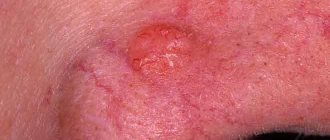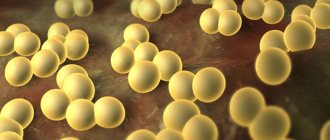Features and classification
Any neoplasm localized on the mucous membrane in the nasal cavity causes a certain discomfort to a person and also interferes with normal breathing.
There are 2 types of such growths:
- exophytic nasal papilloma;
- inverted nasal papilloma.
Type 1 neoplasm has a lumpy surface and a dense consistency. In the photo it looks like a fungus with a characteristic stalk and has a red or light pink tint. Type 2 neoplasm is more often diagnosed in older people. In this case, the risk of bleeding and degeneration of the growth into a malignant tumor is increased.
There is a classification depending on the exact location:
- papilloma of the nasal cavity (for example, on the septum, on the mucous membrane of the organ);
- papilloma of the nasal vestibule (under the nose, at the tip).
Neoplasms in the vestibule of the organ are formed from epidermal cells and do not differ much from growths localized in other areas of the body. They have a lumpy surface, a dense structure, and a thin stalk at the base.
Neoplasms in the nasal cavity are a rare phenomenon that occurs more often in older people. In children, such growths are diagnosed in isolated cases. They grow rapidly, destroying soft tissue and bone walls.
How to remove a wart on the nose at home
In real life, warts on the nose cause trouble for many people, regardless of their nature.
Viral tumors are localized on the skin of the nose or the mucous membrane lining the inside of the nose. Three types of warts may appear on the nose:
- Ordinary (has the shape of a nodule);
- Flat (rises flat above the surface of the skin of the nose);
- Thread-like (the growths have the appearance of a thread or, in case of multiple accumulations, they are compared to the comb of a rooster).
Warts on the nose rarely cause pain in patients; the main complaint is a cosmetic defect and the inconvenience of facial care.
Sources of formation
The reasons for the formation of such neoplasms in various areas, including the nasal region, are always associated with the penetration of the corresponding virus (HPV) into the body.
The latter is transmitted through sexual contact or domestic contact (less commonly). There is a hereditary theory of infection, when a child of a sick mother is born already infected.
If the immune system is strong enough, it is able to fight on its own against many pathogenic microorganisms that penetrate organs and systems. When exposed to provoking factors, the protective function is weakened, which creates good conditions for the reproduction and functioning of the infection.
This:
- abuse of alcoholic beverages and smoking;
- frequent acute respiratory viral infections and acute respiratory infections in the anamnesis;
- stage of exacerbation of any chronic disease;
- insufficient content of vitamins and microelements in the body;
- living in unfavorable environmental conditions;
- increased air humidity in the living room, which is observed on an ongoing basis;
- long-term therapy with potent drugs, such as hormones.
Due to the fact that the disease has a viral etiology, it is considered contagious.
About nasal polyps
Nasal polyps are formations represented by hypertrophy (overgrowth) of the mucous membrane and located in the nasal cavity or paranasal sinuses. Such mucosal hypertrophy is characterized by the passage of several stages:
- The polyps are small enough that they practically do not interfere with nasal breathing;
- The polyps enlarge, which leads to the blocking of more space in the nasal passages;
- Polyps completely block the nasal passages, impairing breathing through the nose.
Nasal polyps are a fairly common disease among the adult population. Usually they are not detected immediately, because symptoms begin to bother a person only when the polyps become quite large in size and interfere with nasal breathing. Modern medicine has difficulty coping with this disease, and does not always allow getting rid of polyps quickly and painlessly. That is why you should not prolong the disease and endure the symptoms of the disease! If you are suddenly diagnosed with nasal polyps, immediately seek help from qualified specialists.
Symptoms of nasal polyps
Symptoms of nasal polyps, as mentioned above, do not appear immediately. It all starts with nasal congestion and difficulty breathing through the nose. In the initial stage, these symptoms appear and disappear.
Over time, the symptoms of the disease progress and the patient's condition worsens. Many people resort to using vasoconstrictor nasal drops, but their effect is not long-term.
Due to impaired nasal breathing, various viral and bacterial infections occur in the form of frequent colds. In addition, snoring may occur. In advanced cases, if the patient does not see a doctor for too long, the polyps grow to such an extent that impaired nasal breathing does not go away during the day and torments the person around the clock
What symptoms characterize the pathology?
Papilloma on the nose of a child and an adult is visible to the naked eye. It is more difficult to identify a growth in the organ cavity. In most cases, when people feel a lump, they begin to pick at it, but this is wrong and can cause bleeding.
The characteristic symptoms of a tumor in the nasal area are as follows:
- a feeling of congestion on the part of the formed neoplasm (occurs when the growth is large and blocks the lumen);
- discharge of mucous exudate from the cavity, which is caused by improper distribution of mucus and increased secretion of mucoid glands;
- the appearance of nosebleeds from the affected nostril (characterized by spontaneous stopping);
- frequent headaches that occur due to blocked nasal passages and breathing problems;
- development of swelling in the sinuses and sinusitis;
- loss (partial or complete) of smell, especially if the growths are localized in both nostrils;
- impairment of auditory function and its decrease if the pathological process has spread to the area of the Eustachian tube and nasopharynx;
- increased tear production due to the fact that the nasolacrimal canal is clogged.
When the infraorbital nerve is involved in the pathology, numbness of the cheek occurs.
Reasons for appearance
Any warts on the human body are identified as benign formations. The cause of warts on the nose is the human papillomavirus (HPV). This virus is considered the most widespread on earth: more than 85% of the population is infected with benign forms of HPV.
The human papillomavirus is transmitted through household contact and develops on damaged areas of the skin. In most cases, when using hygiene products and personal belongings of an infected person, transmission of the virus occurs. The effect of the virus begins with its entry into microcracks in the epidermis, which are an excellent environment for the growth of warts.
After the incubation period of the virus has passed, a growth forms, which increases in size over time. But the mere fact of being infected with HPV does not guarantee the development of a wart on the nose. For the full formation of a seal on the nose, it is important to have provoking conditions related to the patient’s health:
- endocrine diseases,
- metabolic disorders (diabetes mellitus),
- taking contraceptives leading to hormonal imbalance,
- lack of personal hygiene,
- other infectious diseases,
- disordered sex life,
- disruption of the sebaceous glands,
- severe stress,
- poor environmental situation in the region of residence.
The appearance of a growth on the nose during pregnancy is a very common phenomenon, since during pregnancy a woman’s body undergoes serious changes. If the provoking factor has lost its strength, the wart goes away on its own within six months. If the tumor growth rate is high, you should consult a doctor who will prescribe wart removal.
Diagnostic measures
The therapist will tell you which doctor to contact at the patient’s initial appointment. As a rule, a dermatologist deals with pathology.
To make a diagnosis, the following activities are carried out:
- for superficial growths - external examination, biopsy of the neoplasm with histological analysis of the biopsy sample taken;
- for internally located growths - sinusoscopy, rhinoscopy (followed by biopsy), computed tomography and magnetic resonance imaging, x-ray examination.
An immunological analysis is also prescribed (especially for persons with multiple neoplasms), the results of which can reveal an increase in the level of immunoglobulin A and E, a decrease in immunoglobulin M and G, and a decrease in the level of interferon production.
Complications and consequences
Treatment of growths in the nose
Before treating neoplasms in the nasal cavity, a comprehensive diagnosis is prescribed, including to the patient’s relatives, since the virus can be easily transmitted through household contact. What to do and how to get rid of the growth depends on the stage of development of the pathology, as well as the individual characteristics of the body.
If the wart is small in size, does not cause discomfort to a person, or does not interfere with respiratory function, specific therapy is not carried out. However, most dermatologists believe that such growths are best removed surgically. This will prevent the wart from degenerating into cancer.
The doctor also decides how to remove papilloma in the nasal area. Today, there are several surgical methods for getting rid of growths:
- Endoscopic surgery. During the procedure, an endoscope with a microcamera at the end is inserted into the nasal cavity. The picture is displayed on the monitor screen. The neoplasm is excised using a scalpel. The advantage of the operation is the absence of scars and stitches after the procedure.
- Radical surgery. The cavity is opened through an incision and the papilloma is removed using a scalpel. The intervention will be followed by long-term rehabilitation.
- Laser surgery. Prescribed to remove growths that are located under the nose, on it and in other accessible areas. Even children are allowed to perform the operation. The only contraindication is extensive damage.
Removal at home is carried out using folk remedies, but only for superficial papillomas that develop at the initial stage. To do this, use a golden mustache, the juice of which is applied to problem areas several times a day for a week.
You can replace the golden mustache with celandine, rowan, calendula, and nettle. Onion juice mixed with honey in equal volume is effective in treating papillomas. Compositions containing alcohol are not used, because they cause burns to the mucous membrane.
Prevention and prognosis
First of all, to prevent infection with papillomavirus, avoid contact with infected people.
It is also necessary to monitor the state of the immune system, improve the condition by taking vitamins, hardening, maintaining a healthy lifestyle, and maintaining proper nutrition.
It is worth noting that I visit other places:
papillomas on the eyelids
- papillomas on the tongue,
- papillomas in the mouth,
- papillomas in the throat,
- and even on the lips.
Are warts on the nose dangerous?
New growths on the nose are almost always subjected to physical or chemical influence - they are caught by clothing, a handkerchief, or hands.
The nose gets portions of cosmetics, shaving products, creams.
Any damage to the wart is fraught with the development of complications. Dermatologists often treat inflamed, festering papillomas on the nose. This not only brings discomfort to the patient in the form of pain, but also significantly slows down the healing process.
Tearing off a wart will invariably lead to the appearance of a new one in the same place. And over time, papillomas will multiply and there will be several of them, the number will constantly grow.
Psychological complexes caused by a cosmetic defect worsen the patient’s mood, and the whole body begins to suffer.
The listed points prove the need for competent treatment of warts on the nose.









